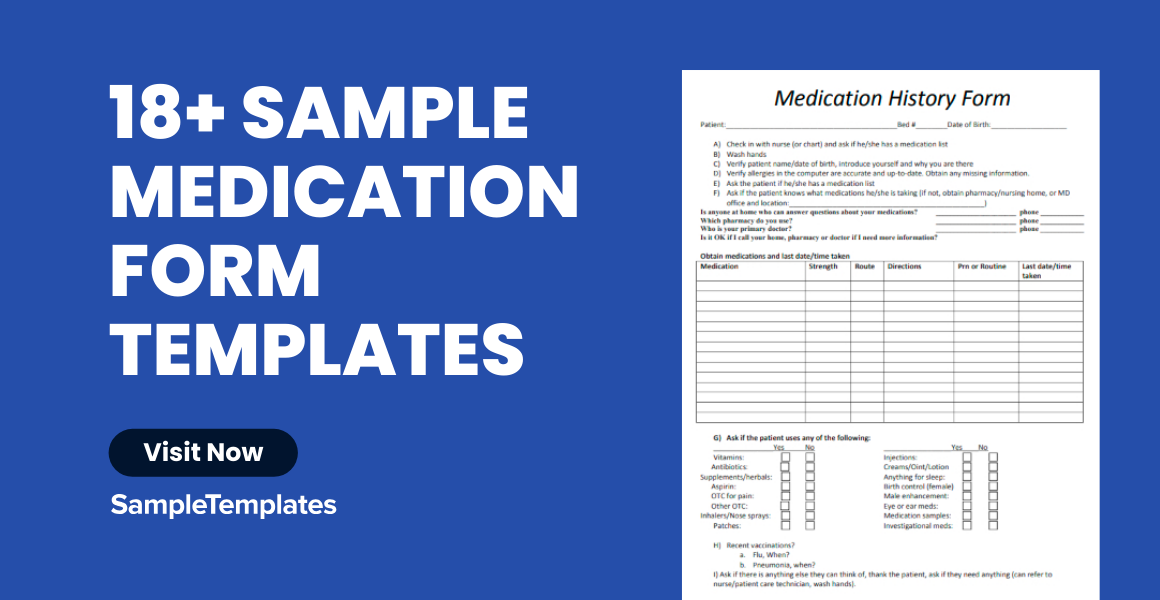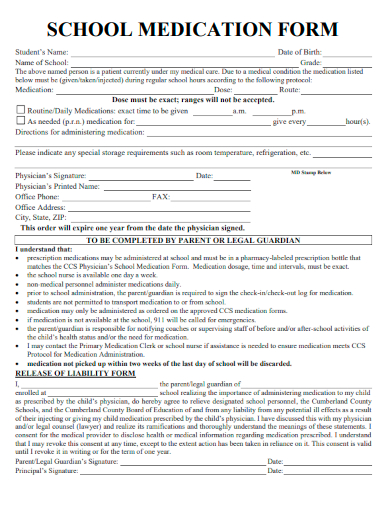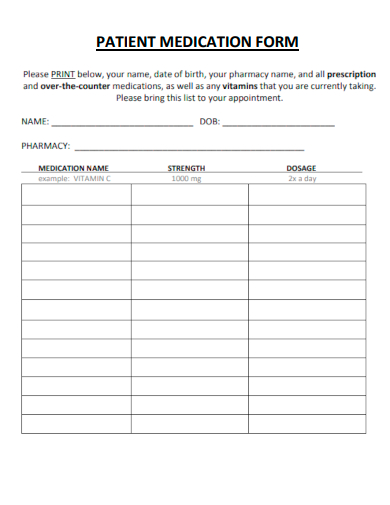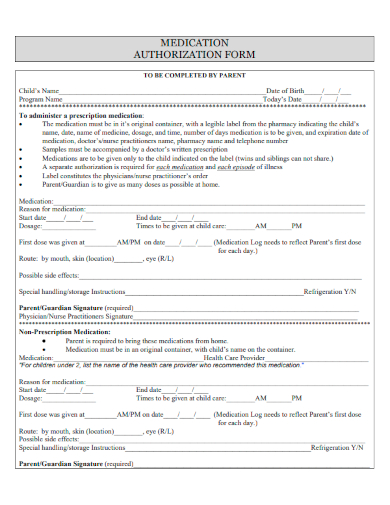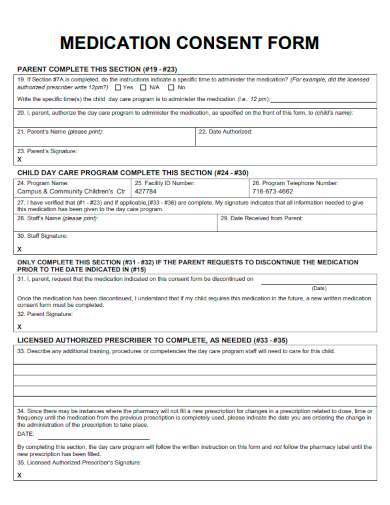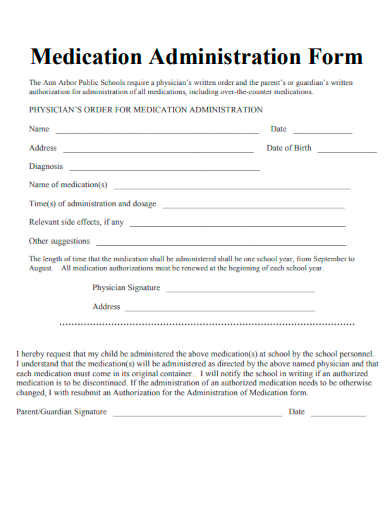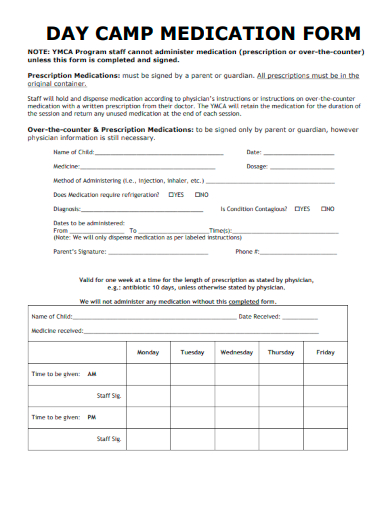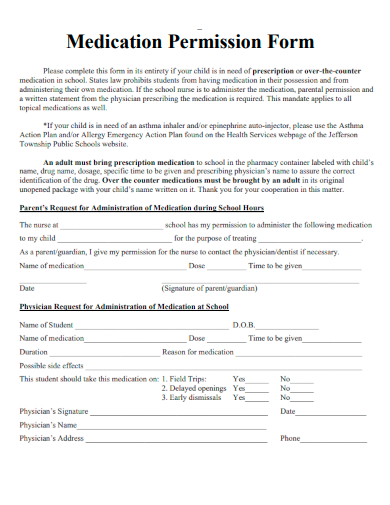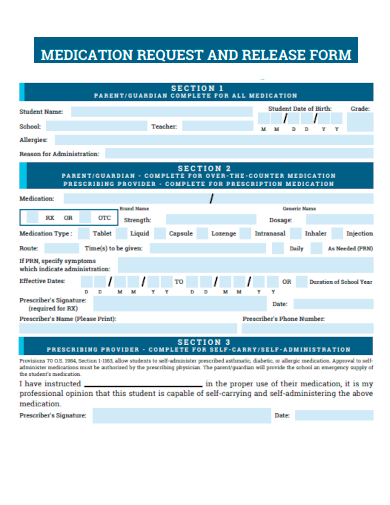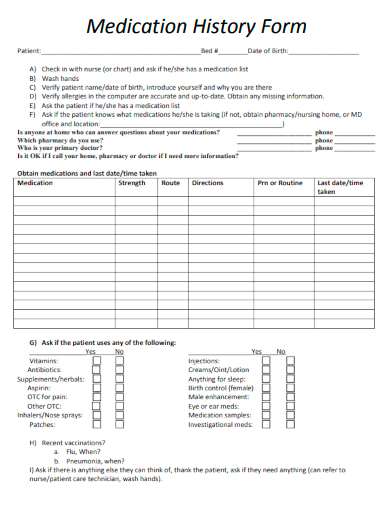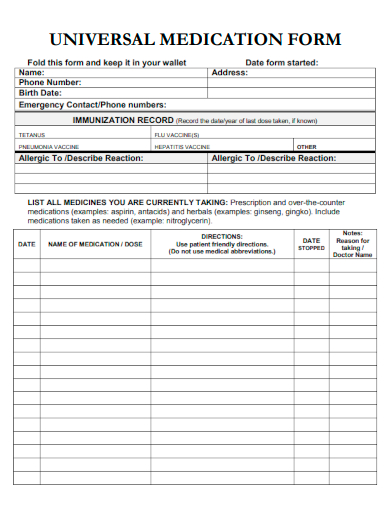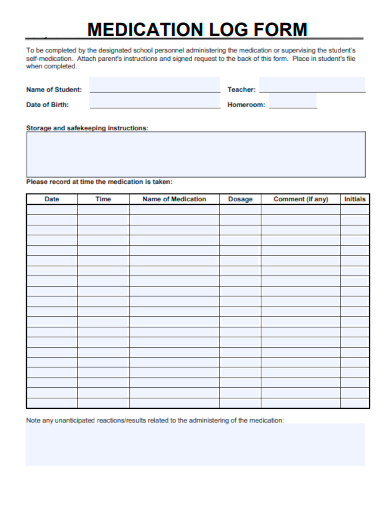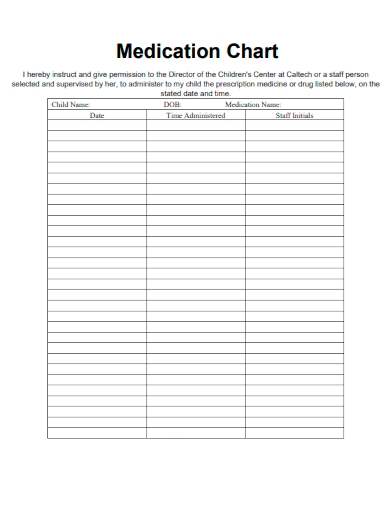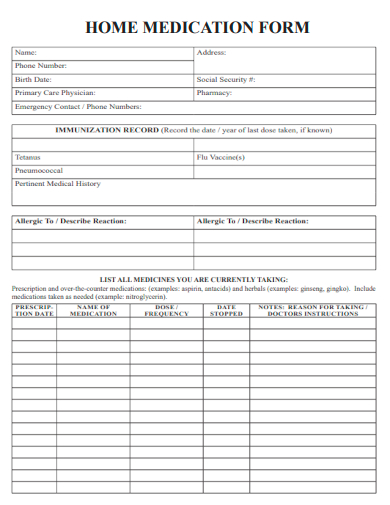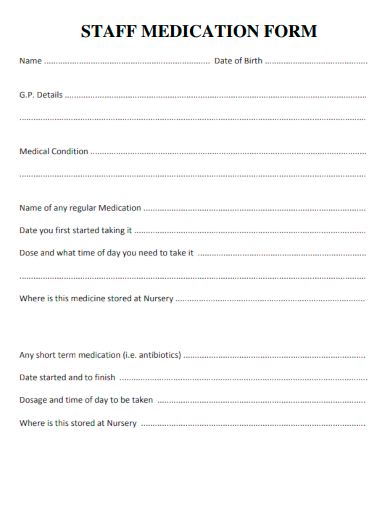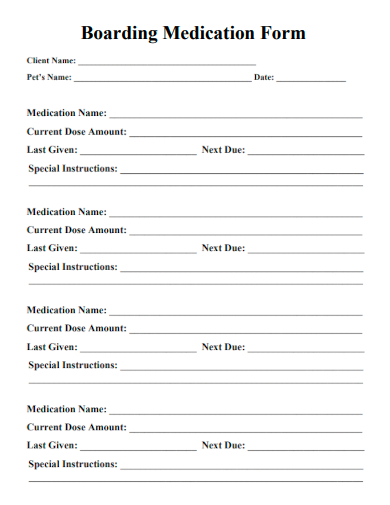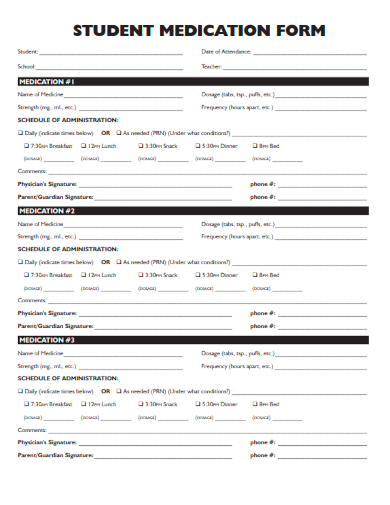Ensuring proper medication management is a cornerstone of effective healthcare. Our Sample Medication Form provides an organized platform for this vital task. By utilizing a detailed medical form, patients, caregivers, and healthcare professionals can easily track and verify dosages, reducing errors and promoting well-being. Dive into our meticulously designed form and witness firsthand the benefits of structured medical record-keeping.
FREE 18+ Medication Form Samples
1. Medical Form Template
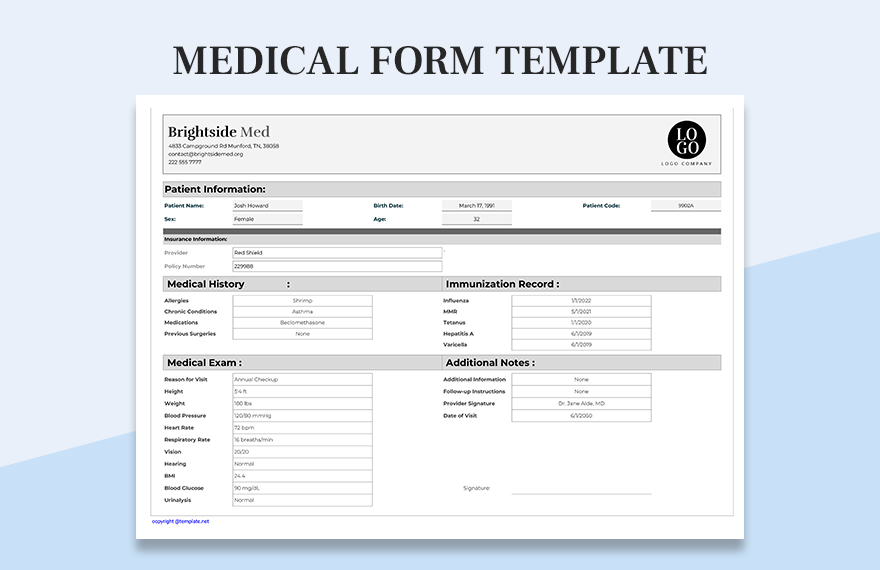
2. Medical Assessment Form Template
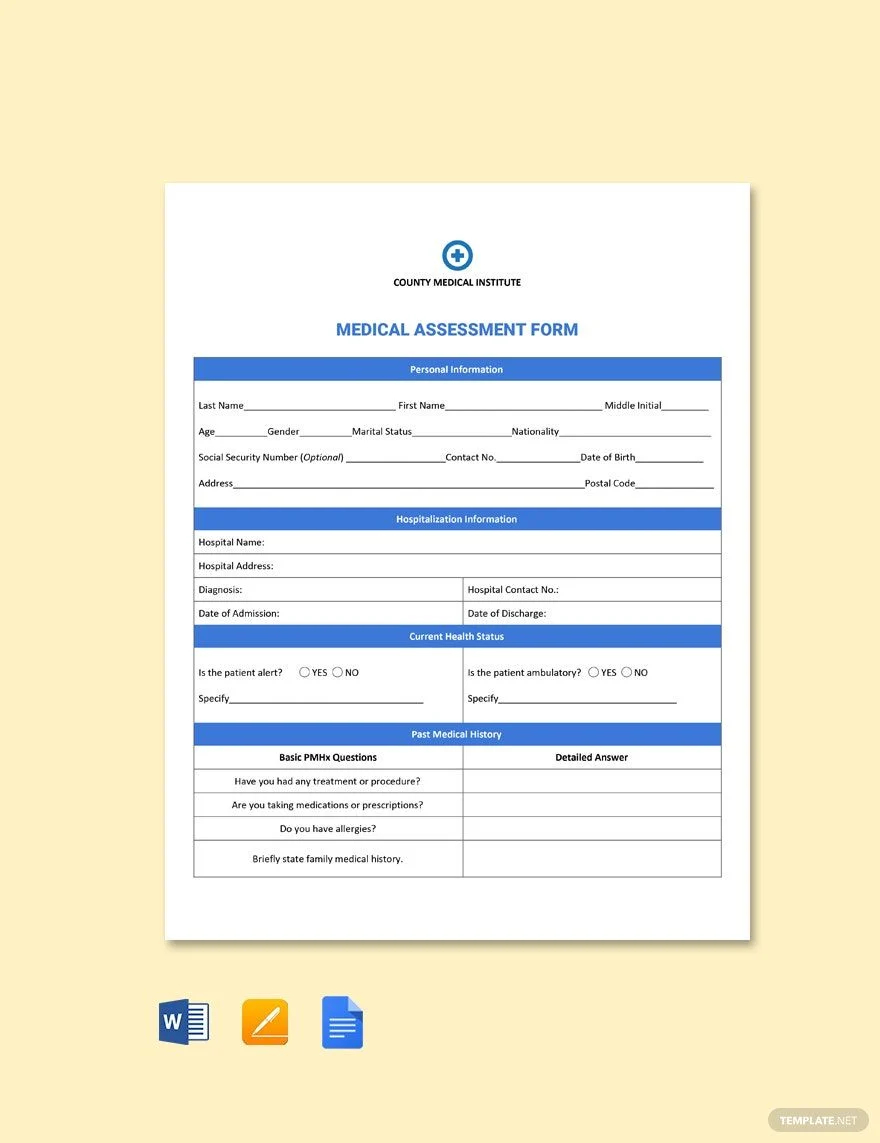
3. Sample School Medication Form Template
4. Sample Patient Medication Form Template
5. Sample Medication Authorization Form Template
6. Sample Medication Consent Form Template
7. Sample Medication Administration Form Template
8. Sample Day Camp Medication Form Template
What is the Medication Form?
The medication form, often referred to as a medication administration record or simply a med list, is a document that systematically captures information about the medications a person is currently taking or has been prescribed. This tool is fundamental in the healthcare industry, both for individual patients and medical professionals.
Purpose and Importance
The primary purpose of a medication form is to ensure the safe and accurate administration of drugs. Here’s why they are indispensable:
- Clarity and Organization: It’s easy to get confused, especially when handling multiple medications with varying doses and administration times. A medication form organizes this information, reducing the risk of errors.
- Communication Among Healthcare Professionals: Different healthcare professionals might be involved in the care of a single patient. The form ensures that all are on the same page regarding a patient’s medications.
- Monitoring and Review: Over time, medications might change. The form allows for easy monitoring of what’s been taken and aids in the review process when adjustments are needed.
- Safety: It minimizes the risk of drug interactions or overdoses. By having a complete list, it’s easier to cross-check and identify potential issues.
Key Components
A typical medication form includes:
- Patient Information: Name, age, date of birth, and other identification data.
- Medication Details: Name of the drug, dosage, frequency, route of administration (e.g., oral, IV), and purpose or indication for the drug.
- Administration Record: A log of when the medication was administered, especially useful in settings like hospitals.
- Additional Notes: Any observations, side effects, or special instructions related to the medication.
Usage Across Settings
While most commonly associated with hospitals and clinics, medication forms are useful in various settings:
- Home: Individuals can use them to track their daily medications.
- Care Homes: They help staff ensure residents receive their medications properly.
- Schools: For students requiring medications during school hours, a form helps keep track and provides clarity for school nurses.
How Do You Make a Medication Form?
Creating a medication form involves a systematic approach to ensure that it’s comprehensive and functional. Here’s a step-by-step guide:
Gather Necessary Information
Before designing the form, collect all the essential data:
Patient Details: Full name, age, any known allergies, and other relevant identification.
List of Medications: Gather all medicines, including over-the-counter drugs, prescriptions, and supplements.
Choose a Format
Decide if you want a digital format (like a spreadsheet or app) or a paper-based format. Each has its pros and cons:
Digital: Easily updated, can set reminders, and can be shared electronically.
Paper-Based: Doesn’t rely on technology, can be posted in a visible location, and is tangible.
Design the Layout
A clear layout is crucial:
Header: Place the patient’s identification at the top for easy reference.
Columns: Consider having columns for medication name, dosage, time/frequency, route, purpose, and additional notes.
Log Section: If desired, include a section where the person can check off or note down when they’ve taken the medication.
Include Safety Measures
Safety should always be paramount:
Color Coding: Use colors to indicate different classes of drugs or highlight critical medications.
Allergy Section: Make a clear, standout section to list known drug allergies.
Regularly Update the Form
Medication regimes can change, so ensure the form is kept up-to-date:
Review Periodically: Make it a habit to review and update the form regularly, especially after doctor visits or hospital stays.
Old Medication Records: If a drug is discontinued, don’t erase it. Instead, strike it through and note the date. This can be useful for historical reference.
Backup and Share as Needed
Having backups and sharing the form can be invaluable:
Multiple Copies: Especially if using a paper form, have multiple copies. One for home, one in your bag, and perhaps one with a close family member or friend.
Digital Sharing: If using a digital form, consider cloud storage for easy access and share with relevant people, like your primary healthcare provider.
Remember, a medication form is a living document. As medications and conditions change, the form should evolve to reflect those changes. Regular maintenance and reviews ensure its effectiveness and, by extension, the health and safety of the patient.
9. Sample Medication Permission Form Template
10. Sample Medication Request & Release Form Template
11. Sample Medication History Form Template
12. Sample Universal Medication Form Template
13. Sample Medication Log Form Template
14. Sample Medication Chart Form Template
15. Sample Home Medication Form Template
16. Sample Staff Medication Form Template
17. Sample Boarding Medication Form Template
18. Sample Student Medication Form Template
19. Sample Medication Request Form Template
The Importance of Maintaining the Medication List and Form
In the realm of healthcare, the medication list and form play an indispensable role, acting as crucial tools in ensuring patient safety, continuity of care, and efficient medical practices. These documents, while seemingly simple, are foundational in bridging the gap between complex medical jargon and patient understanding. Below we dive into why maintaining an up-to-date medication list and form is of paramount importance.
Accurate Medication History
A comprehensive medication list provides healthcare providers with a snapshot of a patient’s current and past medications. This is invaluable in situations where patients visit multiple healthcare providers or get admitted to different hospitals. Without a consistent record form, there’s a risk of medication errors, overdoses, or dangerous drug interactions.
Enhanced Patient Safety
A well-maintained medication form ensures that patients receive the right medication at the correct dose and at the appropriate intervals. This reduces the chances of adverse drug reactions, missed doses, or therapeutic duplications, ensuring optimal patient safety.
Streamlined Communication
Medication forms act as a standardized communication tool among healthcare professionals. Whether it’s doctors consulting with pharmacists or nurses referring to prescription details during administration, a detailed medication form provides clarity, reducing chances of misinterpretation or oversight.
Empowering Patients
An organized medication list empowers patients by giving them a clear understanding of their treatment regimen. It encourages adherence, allows them to actively participate in their care, and ensures they are well-informed about potential side effects or interactions.
Efficacy in Emergency Situations
In emergencies, every second count. An updated medication list can expedite care by providing emergency responders and doctors with immediate insight into a patient’s medical background, ensuring that any interventions align with the patient’s current treatments.
Facilitating Transitions of Care
When patients move between healthcare settings, such as from a hospital to a rehab facility or from a primary care provider to a specialist, the medication list ensures continuity of care. It reduces the chances of medication errors during these transitions.
Aiding in Clinical Reviews and Audits
For healthcare systems, maintaining structured medication forms aids in clinical reviews, audits, and research. Analyzing these forms can offer insights into prescribing trends, medication efficacy, and areas for potential improvement.
Supporting Telemedicine Practices
As telemedicine becomes more prevalent, having an electronic medication list or form that’s accessible and up-to-date becomes crucial. It ensures that remote consultations are based on the most recent and accurate medication information.
In summary, while the intricacies of medical treatments can be vast and multifaceted, the medication list and form stand out as foundational tools ensuring clarity, safety, and efficacy in patient care. Regularly updating and maintaining these documents is a small yet pivotal step in the broader journey of health and well-being.
Related Posts
Sample Sworn Affidavit Forms
Vehicle Inspection Forms Samples & Templates
Sample Employee Advance Forms
Sample Child Travel Consent Forms
Sample Testimonial Request Forms
Sample Employee Details Forms
Sample Divorce Forms
Sample Attestation Forms
Employee Performance Appraisal Form Templates
FREE 9+ Sample Presentation Evaluation Forms in MS Word
FREE 10+ School Admission Form Samples & Templates in MS Word | PDF
FREE 30+ Patient Consent Form Samples in PDF | MS Word
FREE 10+ Sample Sign Off Form Templates in PDF | MS Word
FREE 11+ Sample Medical Consultation Forms in PDF | MS Word
FREE 8+ Sample Donation Forms in PDF | MS Word
